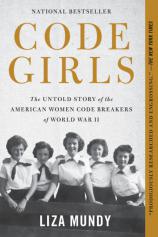Excerpt
Excerpt
Code Girls: The Untold Story of the American Women Code Breakers of World War II

INTRODUCTION
“Your Country Needs You, Young Ladies”
The U.S. military’s decision to tap “high grade” young women—and the women’s willingness to accept the summons—was a chief reason why America, in the aftermath of its entry into World War II, was able to build an effective code-breaking operation practically overnight. That millions of women served the war effort by rolling up their sleeves and donning trousers and jumpsuits to work in factories—the celebrated Rosie the Riveter, who helped build bombers and tanks and aircraft carriers—is well known. Far less well known is that more than ten thousand women traveled to Washington, D.C., to lend their minds and their hard-won educations to the war effort. The recruitment of these American women—and the fact that women were behind some of the most significant individual code-breaking triumphs of the war—was one of the best-kept secrets of the conflict. The military and strategic importance of their work was enormous.
During World War II, code breaking would come into its own as one of the most fruitful forms of intelligence that exists. Listening in on enemy conversations provides a verbatim, real-time way to know what that enemy is thinking and doing and arguing about and worrying over and planning. It provides information on strategy, troop movements, shipping itineraries, political alliances, battlefield casualties, pending attacks, and supply needs. The code breakers of World War II advanced what is known as signals intelligence—reading the coded transmissions of enemies, as well as (sometimes) of allies. They laid the groundwork for the now burgeoning field of cybersecurity, which entails protecting one’s data, networks, and communications against enemy attack. They pioneered work that would lead to the modern computing industry. After the war, the U.S. Army and Navy code-breaking operations merged to become what is now the National Security Agency. It was women who helped found the field of clandestine eavesdropping—much bigger and more controversial now than it was then—and it was women in many cases who shaped the early culture of the NSA.
The women also played a central role in shortening the war. Code breaking was crucial to Allied success in defeating Japan, both at sea and during the bloody amphibious assaults on Pacific islands against a foe that was dug in, literally—the cave fighting toward the end of the war was terrible, as were kamikaze attacks and other suicide missions—and willing to fight to the death. And in the all-important Atlantic theater, U.S. and British penetration of the Nazi Enigma cipher that German admiral Karl Dönitz used to direct his U-boat commanders helped bring about the total elimination of the Nazi submarine threat.
The chain of events that led to the women’s recruitment was a long one, but a signal moment occurred in September 1941, when U.S. Navy rear admiral Leigh Noyes wrote a letter to Ada Comstock, the president of Radcliffe College, the women’s counterpart to Harvard. For more than a year the Navy had been quietly recruiting male intelligence officers from elite colleges and universities, and now it was embarking on the same experiment with women. Noyes wanted to know whether Comstock would identify a group of Radcliffe students to be trained in cryptanalysis. He confided that the Navy was looking for “bright, close-mouthed native students”—that is, high-achieving women who had the sense and ability to keep a secret and who had been born in the United States and were free of close ties with other nations.
“Evidence of a flair for languages or for mathematics could be advantageous,” Noyes said, adding that “any intense sociological quirks would, of course, be undesirable.” Without stating what such “quirks” might be, the admiral suggested that a handful of promising seniors could enroll in a training course the Navy had developed.
“In the event of total war,” Noyes told her, “women will be needed for this work, and they can do it probably better than men.”
Ada Comstock was happy to comply. “It interests me very much and I should like to take whatever steps would be thought serviceable,” she promptly wrote to her friend Donald Menzel, an astronomy professor at Harvard who was serving as a point person for the broader naval recruiting effort. Astronomy is a mathematical science and a naval one—for centuries, navigation was done using the position of the sun and the stars—and many of the instructors who taught the secret course would come from the field.
Comstock also received another letter, this one from Laurance Safford, one of the U.S. Navy’s few experienced code breakers, now responsible for building a much-enlarged code-breaking unit. Safford elaborated on the qualifications they wanted by spelling out the kind of young women the Navy did not want.
“We can have here no fifth columnists, nor those whose true allegiance may be to Moscow,” Safford wrote. “Pacifists would be inappropriate. Equally so would be those from persecuted nations or races—Czechoslovakians, Poles, Jews, who might feel an inward compulsion to involve the United States in war.” Ada Comstock duly put together a list of about forty Radcliffe seniors and young graduate students, with the idea that twenty or so might meet the standards. Disregarding the not-so-subtle anti-Semitism of the Navy’s communications, she included the names of two Jewish women.
Code Girls: The Untold Story of the American Women Code Breakers of World War II
- Genres: History, Nonfiction
- paperback: 448 pages
- Publisher: Hachette Books
- ISBN-10: 0316352543
- ISBN-13: 9780316352543


